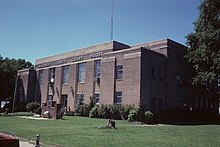Wagoner County, Oklahoma
| Wagoner County, Oklahoma | |
|---|---|

Wagoner County Courthouse in Wagoner
|
|
 Location in the U.S. state of Oklahoma |
|
 Oklahoma's location in the U.S. |
|
| Founded | 1907 |
| Named for | Henry "Bigfoot" Wagoner |
| Seat | Wagoner |
| Largest city | Coweta |
| Area | |
| • Total | 591 sq mi (1,531 km2) |
| • Land | 562 sq mi (1,456 km2) |
| • Water | 29 sq mi (75 km2), 4.9% |
| Population (est.) | |
| • (2015) | 76,559 |
| • Density | 130/sq mi (50/km²) |
| Congressional district | 1st |
| Time zone | Central: UTC-6/-5 |
| Website | www |
Wagoner County is a county located in the U.S. state of Oklahoma. As of the 2010 census, the population was 73,085. Its county seat is Wagoner.
Wagoner County is included in the Tulsa, OK Metropolitan Statistical Area.
According to archaeological studies, this area was inhabited by Caddoan Mound Builders during the period A.D. 300 to 1200.
The western area of Wagoner County was settled by the Creek after their forced removal in Alabama in the 1820s. The eastern portion of the county was settled by the Cherokee.
During the Civil War in 1865, the present county was the scene of the Battle of Flat Rock (also known as the Hay Camp Action). Confederate troops led by Brig. General Stand Watie and Brig. General Richard Gano captured 85 Union troops and killed even more that were harvesting hay.
In 1905, the Sequoyah Convention proposed creating two counties from this area. The western half would be named Coweta and the eastern half would have been named Tumechichee. However, failure of the attempt to create the state of Sequoyah negated the proposal. In 1907 at Oklahoma Statehood, Wagoner County was organized. The towns of Porter and Coweta vied with Wagoner as the county seat. The county was named after the town of Wagoner, which won the election. The town was named after Henry "Bigfoot" Wagoner, a Katy Railroad dispatcher from Parsons, Kansas.
...
Wikipedia
